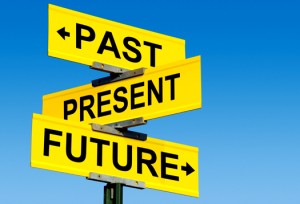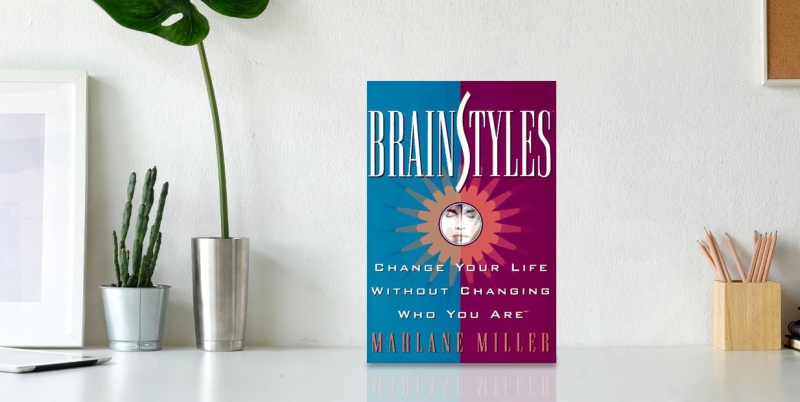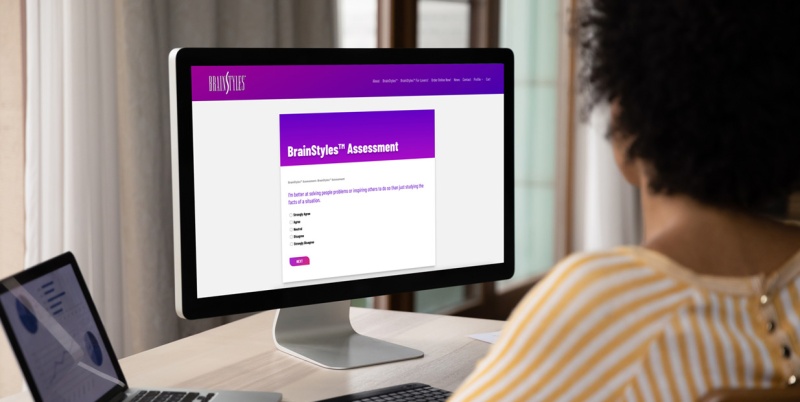- Category: Content
Use your experiences for the future.
 One of the earliest principles to emerge when teaching what was to become The BrainStyles System® was how to “reframe” criticisms by focusing on natural brain-based strengths. This came to mean re-looking at the labels you use to name what you do and who you are with the brainstyles definitions of strengths. Further work led to observations about the source of criticisms, along with the distinction between a brainstyle strength from a non-strength.
One of the earliest principles to emerge when teaching what was to become The BrainStyles System® was how to “reframe” criticisms by focusing on natural brain-based strengths. This came to mean re-looking at the labels you use to name what you do and who you are with the brainstyles definitions of strengths. Further work led to observations about the source of criticisms, along with the distinction between a brainstyle strength from a non-strength.
Taking these one at a time, let’s examine a typical self-criticism I’ve heard again and again from people in one of the brainstyle groups: “I’m too emotional.” The gift of the right-brained is to access the part of the brain that processes emotions first. Doing so allows experience, whole and visual, to influence decisions, interactions and families with a holistic emotional connection, a bonding, if you will. Allowing emotions into the equation means an immediate sensitivity and awareness that the more left-brained do not realize until later. Read more after the jump.
As soon as you hear or become aware of a criticism like the one above, you’ll know there’s a comparison being made. There are right and wrong judgments being made about the way to be you.
One of the mandates I was given by my behavioral science background was “strengths taken to an extreme are weaknesses.” If this is so, then Einstein should have been taken out of physics classes and given courses in literature to be more “well-rounded.” I disagree with the notion that tells us to rein in our strengths. I do so because the old conclusions were based on observance of outward behavior. The new paradigm looks behind the behavior to the hardware that creates it. BrainStyles teaches you how.
Observing the emotive folks among us, I believe that the real meaning of “too emotional” is being reactive, easily swept away by feelings that overpower common sense or logic. In fact, this is easily explained by brainstyle timing. A brainstyle describes how fast access to one area of the brain automatically means a delay in getting to another, different gift—the logic of the left brain, a non-strength in this example. When logic is prized over intuition, the offering of emotional experience or reaction interferes with another’s timing. They criticize. The right-brainer personalizes. Mars and Venus are at war.
Learning about one’s right-brained gift and the timing it requires leads to acceptance. The internal struggle eases, the focus shifts from How could I do that? Why am I so dumb? to Ah, I really feel that. I need a minute to think. Or I can share my reactions to help others understand the impact of this on people. Acceptance of natural strengths brings authentic contribution to the group, the partnership, and the family.
When others criticize, you automatically know they are expecting you to act and think like they do, with their own brainstyle strength. Not going to happen. Expectations, it’s been said, are premeditated resentments. Try to act like he expects you to and loss of self respect starts you down the slippery slope of people-pleasing, co-dependence, resentment and loss of the relationship.
Expectations are the source of upsets and conflicts: Why can’t you be more like your brother? Why can’t you understand what I mean when I say it the first time?
As you learn to focus on your natural abilities, you become less apt to defend, become reactive, or apologize for not being good enough. You will be more apt to offer what you can and cannot deliver in such a way that you develop respect. You re-frame the criticism/comparison into an authentic statement of what you have to offer. The more accepting you are the more neutral you’ll sound. You know, I can’t put things together as quickly and in order as you do, but I can give you a gut reaction that can tell us how to sell this to others. Or: My first take on this is negative, but I need time to think it over before I give you a final answer.
I’d like to share a personal example.
As a young girl, my stepdad had me clean up after our dogs. I had to go in the back yard and clean up their poop before there were pooper scoopers. I hated the job. I thought it was unfair and nasty and horrible. Fast forward to my twenties and thirties. In the lingo of the time, I came to label that childhood assignment as a form of “abuse.” Fast forward to BrainStyles writing and teaching. I am cleaning the litter box for my first kittycat. I recall the time in the backyard of my youth and how put upon I felt. I am touched by a feeling of gratitude. I can clean up my cat’s messes, no matter how gross, and have no problem with them. I saw the past trauma as a label I gave a job that today serves me well.*
Are you interested in taking another look at experiences in your life and reframe them? Visit our website to learn more about how you can get started with BrainStyles today.
*I do not intend to sugar coat some very real cruelty foisted on children by immature adults. I offer this option to “re-frame” old judgments and hurts with the wisdom and perspective of adulthood; to ask what the gift might be behind the behavior.
- Category: Content

Understanding your brainstyle will help you to learn how to effectively communicate with other personalities. In this case study, observe how Gary learns how to handle a tough boss.
Lou was standing when Gary came into his office. He opened impatiently, “It’s been a bad morning, Gary. I hope this won’t take long. I’ve got to catch a plane this afternoon. I just found out an hour ago.” Uh Oh, thought Gary, but, typical for his brainstyle, he showed no visible reaction when under pressure.
Gary, a twenty-nine-year-old plant manager for a well known brand, set a meeting with the operations vice president. He prepared for the meeting for weeks. Gary has held his position for 18 months, and knew it was critically important to impress the man he is looking at across the desk. In fact, it would not be far-fetched to say that this meeting would determine his entire future with the company. Everybody in the office said that Lou the VP had a temper and didn’t put up with much. Gary had heard that people came out of difficult encounters with Lou and “you never heard from them again.” Read more after the jump.
So Gary knew there was a lot on the line and had asked for an extra three days to prepare a report that carefully, thoroughly supported his request for a major expansion to the plant he managed. The amount was several millions and a serious request. Gary had a stack of papers and overheads to show with graphs and charts. And now, horror of horrors, Lou was saying he wanted a one-page summary starting with the “bottom line.” But Gary, given his brainstyle, wanted to explain what was involved in his conclusions so Lou would understand better what the decision required.
The worst then occurred. Lou actually pounded the desk and exploded,, “Damn it, Gary, just give me the punch line! You took an extra three days! What’s the decision?”
It must be said here that Gary had had a few sessions with brainstyles and had spent some time thinking about his strengths and what he was up against in dealing with Lou’s brainstyle. He wasn’t totally unprepared for this reaction, yet even so, his hands were quite clammy and his stomach had settled firmly at his feet. Gary’s natural strengths were solidly in his favor, however. He did not process the feelings as rapidly nor take Lou’s words as personally as some other brainstyles would. He answered rather coolly with what was to become the foundation of the BrainStyles® principles: respect for self and the other without asking that either change.
Gary looked squarely at Lou and said in his soft-spoken voice, “You know, I’m never going to give you the decision you want as fast as you want it. You’ll always be faster at that than I will. But I will tell you this: I will work as hard as I can and as fast as I can to make what I give you as accurate and as solid a decision as possible. It may take a few days longer, but you can bet that when you get it, you can take it to the bank. And,” he added, “there’s too many ‘hip-shooters’ around here. You need someone you can count on.”
Lou actually sat down. He looked squarely at Gary. Gary, he thought, was full of surprises. He concluded that Gary was a straight shooter (a value important to him and his brainstyle), that he was not just making an excuse for delays. It was the truth. From what Lou had seen, he was accurate and thorough. Gary was saying what he could be counted on for, and that he could be counted on to deliver it to meet Lou’s needs to the best of his ability.
Gary walked out with a yes for the $8 million budget increase. When he reached the parking lot he realized that Lou was actually a reasonable guy, and one only needed to approach him in the correct way. They had had a good discussion after Gary’s pronouncement.
They never had another meeting like that one again. Lou became one of Gary’s strongest supporters in the organization, recommending him for several promotions in the next few years. Gary spread the word that changed Lou’s reputation from fire-breather to respected leader. He has continued to apply the brainstyle principles with some half dozen new bosses and new teams that improved their productivity and worked well together by using their differences, including his study team in the Harvard Business School.
Using BrainStyles, Gary was able to understand how his brainstyle processed information and how that differed from Lou, his superior. The result was a productive meeting that led to many more successes within his position as plant manager. If you would like to learn how BrainStyles can help you effectively communicate with your colleagues, visit our website.
- Category: Content
Personal Mastery with BrainStyles™

Marlee Alex, an Oregon writer, begins an article entitled “Listening,” by describing how her self-inflicted criticism turned her natural gift into an adolescent curse.
“I am a listener. Natural born. But I didn’t always value this gift. In my teens I desperately wished to be like everyone else: bubbly, chatty, effusive. I even questioned if something was wrong with me because I was curious and quiet.” What a discovery when she began to see what she could do with the very ability she used to disparage. “I am beginning to see how my ease in listening is an art…. It’s active, involving, participative…” She lists what marvelous things being a listener provides. Without effort, she elicits stories, revealing the inner worlds of others just by being herself and doing what she does most naturally. The difference between Marlee and most of the rest of us? She is just being herself with purpose; she does what she does on purpose. Learn more after the jump.
Marlee volunteers at a women’s prison. What does she do? She is “present,” literally she just sits around, being available, as she communicates her acceptance of the women and where they are in life non-verbally. Mastering her gift of being a quiet introvert, she has developed her own art. Applying a gift in this way, she is a Master, in the fullest sense of the word.
And there’s more. Previously dreading social events, Marlee says, “Now before going to a party, I just tell myself to listen with affection. My attitude is ‘Tell me more.’ The result is [that] a person shows me his soul.” Social life now holds no fear. Marlee has discovered a career, a way to serve in the community, a whole lifestyle of being confident in what she has to offer. With a simple shift, what was invisible is now a celebrated asset. Her true colors, the best of her, are in the spotlight making her own and others’ lives richer and more satisfying.
It would seem most of us just stumble upon our gifts — without training, extra stimulation in pre-school, or even a very supportive environment.
There is a shortcut to a personal awareness of the gifts that can take you to your own personal Mastery. It’s called BrainStyles®, a systematic approach to identifying your natural, hardwired, brain-based gifts that need attention rather than work and stress to nurture and grow.
BrainStyles teaches you how to reframe your “curses” into the blessings that they are, just as the introverted listener became a writer. The approach establishes a framework for opening doors in your life, to create new awareness and lead to loving, respectful relationships. This approach that I live and teach, a philosophy and the tools to apply it, builds self-acceptance that can set you free to create a universe of people whom you appreciate for who they are and, just as importantly, for who they are not. As you do so, you live at ease with your own gifts and limitations. You expand out into life, fearlessly, by using your new wisdom to transform critical or fear-based reactions into more authentic, accepting responses. You give up expectations that just won’t happen. You stop trying to change anyone, especially yourself.
If you would like to get started with BrainStyles, take the personalized BrainStyle Inventory 2.0 (c) and get a 15 page description of your own and others' brainstyles.
- Category: Content
Problem Solving in Marriage
 In this blog post, learn how one husband and wife learned to appreciate each other’s different brainstyle for problem solving in marriage. The result was something that they both wanted – a new boat. Written by master facilitator Linda Bush, notice how each use their strengths work through a problem.
In this blog post, learn how one husband and wife learned to appreciate each other’s different brainstyle for problem solving in marriage. The result was something that they both wanted – a new boat. Written by master facilitator Linda Bush, notice how each use their strengths work through a problem.
The Way We Were
I’m accustomed to high stakes negotiating including several house purchases, corporate contracts while at IBM, and ongoing vendor/supplier deals in my consulting business. Thus, I’ve acquired the role for our family as the leader in major acquisitions. To be honest, I was self-appointed in spite of my distaste for such tasks as the negotiation of price or the comparison of details and facts. And I received praise from friends and family members for “handling it all”. So I kept on.
Soon after I learned about BrainStyles and the Strengths Contract. When my husband Gary and I made our next major purchase, I chose a different role. Learn more after the jump.
New Family Teamwork
From BrainStyles, we learned that we have two different ways of processing new information. I said to Gary, “You’re best at sorting the facts, asking pertinent questions, and focusing. I’m best at relationship building and imagining the possibilities. Let’s approach this purchase in a new way.”
We both pored over the ads. Gary called the sellers and asked the initial pertinent questions and narrowed the list of candidates to visit. We made the visits together, and when we saw a boat we really liked, I facilitated a “get-to-know-you-and-trust-you” conversation with the sellers, while Gary asked blunt and focused questions as he crawled in, around, under and through the craft.
Gary’s left-brained questions:
- Has the prop ever been replaced?
- Are those the true hours on the engine?
- Have you done mostly fishing or water-skiing with those hours?
- How many offers have you already had?
- What were they? Why didn’t you take them?
- Have you done the maintenance yourself or had it done at a dealership?
- Where does the moisture in the storage compartment come from?
- Has the hull ever been painted? If so, why?
- Have the brakes on the trailer ever been maintained?
- How many miles would you estimate are on the tires on the trailer?
- Why is the canopy moldy?
My right-brained questions:
- How long have you been boaters?
- How many children? Ages? Any grandchildren? Do they go along?
- When did you start teaching the kids to water-ski?
- What do your kids think about your selling the boat?
- Where have you done most of your boating?
- How have you managed to keep the seats in such nice condition?
- What will you do without a boat? New interests? Buying another one?
At first I thought some of Gary’s questions were too blunt and probing and sounded untrusting. I wondered if I should soften his interaction. Gary later confessed he thought my questions were too personal and sometimes irrelevant and wondered if he should distract me. Happily, we both let each other interact in our own way.
From our research, the seller’s price was reasonable. I felt good about the couple who was selling the boat and wanted to give them their asking price. Gary was prepared to walk away if they didn’t take his offer of $1,000 below asking price. He offered and they declined. We left in the rain. No boat, no deal. In the car, I expressed disappointment. Gary said, “Honey, there are lots of boats.” All I could think was how perfect this one matched my new Expedition and his F250!
The Win-Win
Two days later, the seller called us, expressed how much they liked us, and said they would meet our offer and throw in competition water skis, a kneeboard, six life jackets, two tow ropes, and a canvas boat cover. Gary asked how soon they could meet us at the bank to transfer funds for title. They arranged to meet in a couple of hours.
I released control of the negotiation and we got the boat we wanted, at the price Gary wanted, with $1,000 worth of barely used equipment.
If you are interested in learning about how BrainStyles can positively affect your marriage, please visit BrainStyles for Lovers. If you would like to meet Linda and learn about leading from your strengths, join us for an upcoming webinar.
- Category: Content
![]()
“Your job in life is not to learn how to be different [or better], it is to spend more time realizing, and living from the best that’s already within. The difference between people who “realize their potential” and those who don’t is not the amount of potential, but the amount of permission they give themselves to use it.”
--Marlane Miller, BrainStyles™: Change Your Life Without Changing Who You Are℠ (Simon & Schuster, 1997), p.29
“Our brains are built to process things in certain ways, and no amount of education or training can take us beyond these built-in characteristics.”
--Michael Gazzaniga, Neuroscientist, Co-Discoverer of left/right brain functions in Nature’s Mind, 1990.
Early results of business applications of BrainStyles research and principles included:
- A national Customer Service team at Procter & Gamble applied BrainStyles to reduce a project timeline from 18 months to 5 months.
- A P&G account team took meetings from 8-hour marathons to two-hour sessions that increased sales by multiples and changed the careers of the team members.
- Allstate Insurance underwriters applied BrainStyles to field support with agents to become Allstate's leading division nationwide.
- HB Communications, a public relations firm in Chicago, brought corporate clients into a BrainStyles seminar to apply brainstyle -based customer-service strategies. Client satisfaction rose as the teamwork within their firm increased.
- A team of highly conflicted members used BrainStyles to initiate a publishing project. It was completed from idea to hardback book in 6 months while all team members had other full-time jobs. The team credited BrainStyles for learning how to leverage both brainspeed and individual brain-based strengths to collaborate smoothly and far more efficiently than ever before.
- Category: Content
BrainStyles has helped many major corporations and organizations improve their teamwork and productivity. Here is a sampling of who we have helped:

|
|

- Category: Content
The BrainStyles System® goes BEYOND personality to the genetic brain hardware that defines how you think when you are at your best--at home, at work and at play--and shows you how to focus on your natural gifts without trying to change anyone. Avoid the Two Basic Errors: 1) Overlook your natural strengths, and 2) Focus on your weaknesses.
Why wait? Learn how you can Change Your Life WITHOUT Changing Who You AreSM. Take The BrainStyle Inventory© and receive a comprehensive report on all the brainstyles.
 Go Beyond Personality Tests
Go Beyond Personality Tests
Each of us has a natural BrainStyle wired from our genes. Find out what your brainstyle is, how it mandates your strengths, and how to live from them.
 BrainStyles for Relationships
BrainStyles for Relationships
Apply simple, powerful principles to family & relationships where no one has to change. Respect grows and conflict decreases.
 FREE BrainBursts℠
FREE BrainBursts℠
FREE articles we call "BrainBursts℠ offer valuable tips on using your brain power in your daily life.



